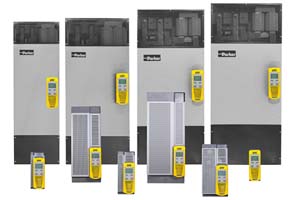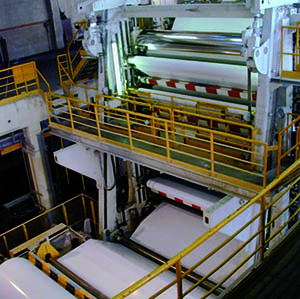 Stretch films are essential in the packaging industry as they provide a versatile and high-quality solution for packing products in a safe and economical way. Film is produced by a flat die extrusion process where AC motors and AC variable speed drives play a significant role in ensuring a high-quality output.
Stretch films are essential in the packaging industry as they provide a versatile and high-quality solution for packing products in a safe and economical way. Film is produced by a flat die extrusion process where AC motors and AC variable speed drives play a significant role in ensuring a high-quality output.The process starts with the extruder that is essentially a pump that melts and transports fluids of high viscosity. The polymer enters into the extruder via a gravimetric feed, and through the combined actions of heat and mechanical stress, the material is melted, mixed and pushed through an extrusion head to give the desired shape. After exiting the extrusion head, the material enters a cooling unit, here water cooled ‘chill rolls’ reduce the temperature of the film before it is finally wound onto rolls.
Extruder
The extruder consists of a hollow cylinder in which rotates a single or double screw driven by an electric motor; this is usually coupled to the plasticising screw by a gearbox. The motor provides the torque required and rotates at a speed necessary to obtain the expected melt flow rate. Any failure in the precise control of the screw speed can cause changes in film thickness in the machine direction.
For the past 20 years, AC motors have typically taken over from DC motors in the control of the extruder screw in cast film line applications. They have been able to deliver many advantages in terms of convenience, reliability, low maintenance and a reduction in the overall dimensions of the system solution. AC motors are controlled by AC variable speed drives that guarantee stable rotation - even at very low speeds (via a closed loop circuit through incremental encoders), provide short circuit protection (low or high voltage), and incorporate EMC filters to eliminate electrical noise and interference.
In recent years, along with AC motors and drives, torque motors have also been utilised in screw extrusion control. These offer a complete direct drive solution that does not require the assembly of different elements such as a gearbox, belts, and pulleys. Torque motors guarantee uniformity in the motion, linearity, and constancy in the extrusion of the plastic material.
Cooling section
As previously mentioned, when the material leaves the extrusion head, it is melted on chilling rolls that form the cooling section of the cast film production line. The cooling unit is comprised of a primary quenching roll, that cools the film on one side, and a secondary roll, that cools the film on the opposite side. It also includes a motorised roll positioning system for correct vertical and cross-machine direction alignment of the rolls, and in many cases a vacuum box and/or air knife.
The rolls must be perfectly aligned with the web to guarantee uniform tension and to minimise thickness variations across the width of the film. In addition, the angular velocity of the rolls must be well controlled to prevent film thickness fluctuations in the machine direction.
Accumulator and winder section
 Within the cooling and winding sections, we find the accumulator, this is used to allow splicing of the web being fed from an empty winder to a full winder at zero speed without stopping the line.
Within the cooling and winding sections, we find the accumulator, this is used to allow splicing of the web being fed from an empty winder to a full winder at zero speed without stopping the line.
At the end of the process, a further winder brings the extruder material onto rolls. The winding process has to preserve the film’s properties and dimensions when the rolls are unwound in other downstream processes.
There are several different types of winders, although the typical one used one in cast film applications is a ‘turret’ or ‘centre’ winder where the web tension decreases as the roll diameter increases.
All the movements performed in the cooling, accumulator and winder sections are driven by AC motors and drives that govern the web speed and the correct web tensioning.
AC Drives and Motors
AC Drives with high-end control are very important for guaranteeing high-quality film throughout the process. Easy-to-configure software for the closed-loop control and optimum efficiency for many different types of material is a vital element of a cast film line system and process.
Parker's AC30 series with power ratings ranging from 0.75 to 450 kW coupled with the company’s Quicktool software with full IEC61131PLC functionality or Parker DSE Lite software, provides all the features needed to achieve optimum synchronisation between all line sections. It allows customers to create, parameterise and configure user-defined applications using dedicated function blocks such as the winder, PID and diameter calculator. The AC30 series also provides access to a large library of application macros and worked examples.
Connectivity via EtherCAT, Profinet, Ethernet IP and Modbus TCP IP through a dual Ethernet port enables communication between individual drives in a simple and flexible way and supports intelligent data analytics and connection to external servers. The line setpoint can be sent through a very fast channel supported by 1588 time synchronised peer-to-peer communication, and each part of the machine has its own regulation, either within the drives or through communication protocol by the PLC.
An animation shows how a high-performance drive solution supports the optimal control of a cast film line.

Article contributed by Jean-Philippe Olry, application engineer industrial market, Electromechanical & Drives Division Europe of Parker Hannifin Corporation.